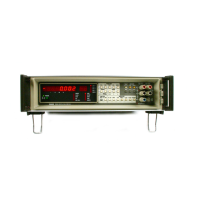8505A
value and
display the
ratio. An offset
value can be
subtracted from the
measured value to display
only the
deviation.
Scaling (or External Reference) and Offset
can
be
used in
combination to display percentage variation.
Examples of such
operations
are given under
Applications
later in this section.
2-88.
Use of
mathematic operations is expressed in the
following
formula:
MEASURED
VALUE
DISPLAY
=
OFFSET
SCALING
(OR EXTERNAL
REFERENCE)
Measured
value in this formula refers to the measurement
as
influenced by
all selected measurement parameters.
This value is subject
to the following function-dependent
considerations.
1
.
V DC function: measured value is the measured
voltage less
V DC Zero when the Zero mode is
used.
2. OHMS
function:
measured value is obtained
after any
applicable OHMS
Zero is applied.
2-89.
SCALING
2-90.
The Scaling mode divides the measured
value
(after
application of V DC or
OHMS zero)
by a
known
amount and displays the quotient. Ratios,
percentage
deviations,
or input/
output relationships
can thereby
be
displayed. The scaling divisor may
be a previously
displayed
and stored value, or any non-zero
numeric
entry from +10
9
to
+10'
9
and
from
-10
9
to
-10'
9
. When
compared to External Reference, Scaling offers
a much
wider range. Only one scaling factor may be stored
at a
time.
2-91.
Storing the
displayed value
as a scaling factor
warrants
a
word of caution: insure that the
displayed
value
is
the true original display
by
first toggling out
of
Scaling and Offset modes (respective annunciators off).
No
stored scaling or offset
value
is lost in this manner. To
store the
desired display, push
STORE SCALING.
NOTE
If
the multimeter is in both Scaling
and
Offset
modes, the scaling value is applied
before the
offset
value.
2-92.
EXTERNAL REFERENCE
2-93. Scaling and External
Reference modes are
mutually exclusive: selection of either
mode
automatically
disables
the other. The external reference
value (always
measured
as a dc voltage) is applied
as an
unswitched input
through the rear
input connector.
2-94. Immediately after a power-up or reset,
RECALL
EXT REF can be used to verify the software version
number. The
first subsequent
use of EXT REF to activate
External Reference mode disables this
software
identification feature.
When
toggling into the
mode, the
reference
voltage is displayed
as iong as the EXT
REF
button is depressed. The EXT annunciator is
lighted
when the mode
is enabled.
2-95.
The
applied
External Reference voltage
may be a
maximum of
±20V dc on either high or low input
with
respect to
VOLTS INPUT LO. The voltage
between
External
Reference high and low may not exceed 40V dc.
The minimum
acceptable External Reference voltage is
the
greater of ±1 00 u
V or
a
value found with the following
formula:
±
Vin
Vmin
=
-Jq^-
2-96. Normally, the External Reference low terminal
is
tied to VOLTS INPUT LO.
In
any event, the resistance
between
either External Reference terminal
and VOLTS
INPUT LO should be less than 20 kilohms. A reading
rate
of eight
samples-per-reading
and filter bypass
are
specified
for each External Reference input.
2-97.
OFFSET
2-98. In Offset mode, the display represents only
the
deviation from a stored offset value. Measurements
of
stability
of
analog variation are thereby possible.
The
multimeter automatically
subtracts
a programmed
numeric (or previously stored display value)
from the
measurement and displays
the
result. No increase
in
resolution is displayed while
in the
Offset mode.
One
value
(whether
a numeric or a
previous display)
may
be
stored at a time. Programmed
numerics
may range from
+10
9
to
-10
9
(excluding
0).
The stored offset value
may be
recalled at any time.
2-99.
Special Operations
2-100.
PEAK
2-101. The highest and lowest deviations
in the
displayed
value may be recorded in the
Peak mode.
Measurement stability may thereby be checked
over a
period of time. The PEAK push button toggles
into/ out
of the Peak mode. High and low Peak values
may be
recalled any
time without exiting the Peak
mode or
interrupting further peak recording. The following
sequence is used:
RECALL HI PEAK
RECALL LO PEAK
The
high or low peak value is latched in the display
as long
as the
PEAK button is held depressed.
2-102. Exiting the Peak mode (toggle PEAK
once) halts
further peak recording, but does not erase previously
recorded high and low values. A multimeter function
change disables Peak mode
and
retains peak values. At
any time, reentry
into the Peak mode (toggle
Peak again)
2-23

